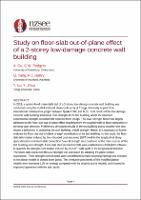Study on floor-slab out-of-plane effect of a 2-storey low-damage concrete wall building

Download
Date
2022-04-27Authors
Gu, Anqi
Henry, Richard
Rodgers, Geoffrey
Yang, Qun
Lu, Yiqiu
Zhou, Ying
Metadata
Show full item recordAbstract
In 2019, a system-level shake-table test of a 2-storey low-damage concrete wall building was conducted using the multi-functional shake-table array at Tongji University as part of an international collaborative project between QuakeCoRE and ILEE. Test results of the low-damage concrete wall building showed an over-strength of the test building where the observed experimental strength exceeded that expected from design. This over-strength factor was largely attributed to the floor-slab out-of-plane effect resulting from the coupled wall-to-floor connection in the long-span direction. Preliminary simulation results of the test building planar models have also shown a deficiency in predicting the wall building overall strength. Hence, it is necessary to further evaluate the floor slab out-of-plane strength contribution to the test building. In this study, the floor slab deformation induced by the unbonded post-tensioned (UPT) wall in the longitudinal (long-span) direction and beam-slab connection flexural strength are considered as the main sources of the test building over-strength. Floor slab shell element models were established in ABAQUS software to quantify the strength contribution induced by the UPT wall uplift in the longitudinal direction. The beam-slab connection flexural strength was calculated by adopting the plane section assumption. These strength contributions were simplified to lumped rotational springs and included in the planar models at slotted-beam joints. The overturning moments of the modified planar models were increased 12% on average compared with the original planar models, and showed an improved agreement with the test results.
